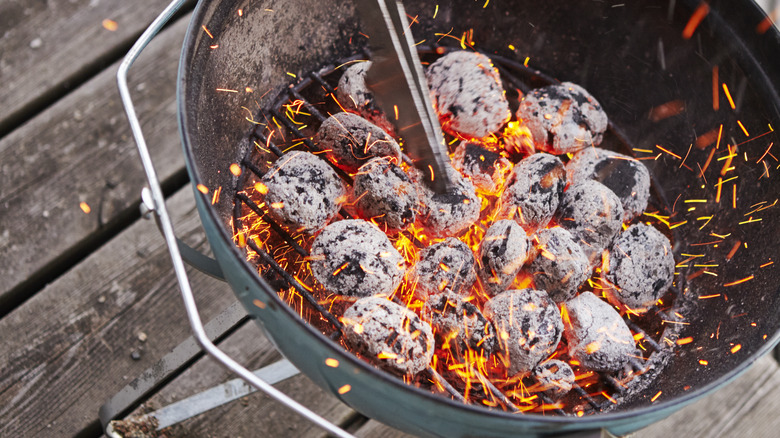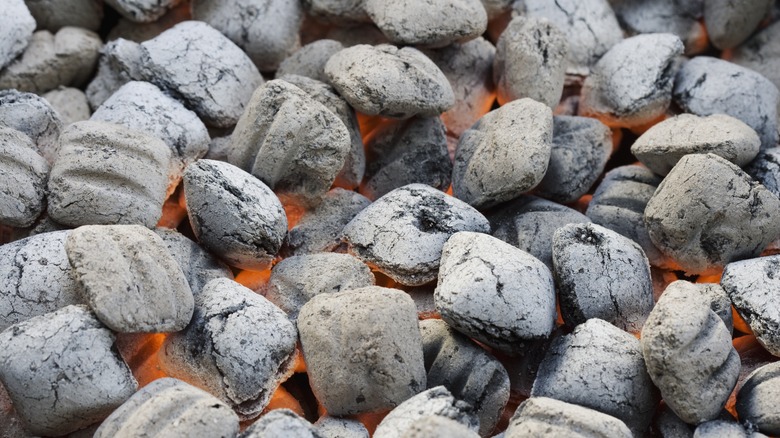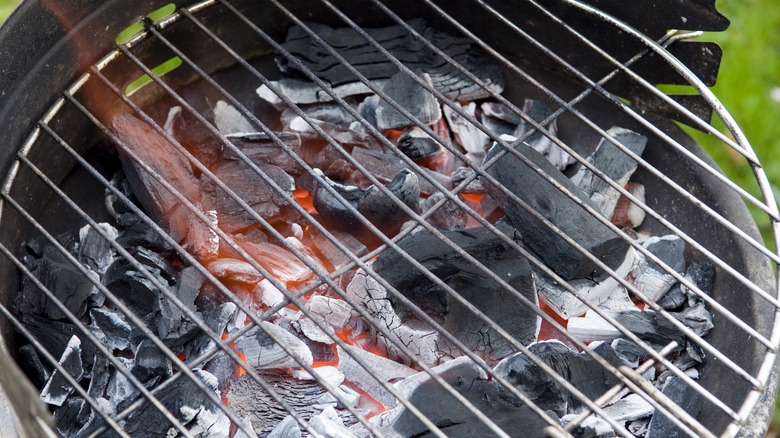This Is How You Keep That Stubborn Charcoal Grill Fire From Going Out
Charcoal grills are notoriously stubborn. Without the right amount of finesse, patience, and skill, your coals won't stay lit and your fire won't burn hot enough to cook anything. With so many components to master, it's good to know tips and tricks that will keep your barbecue burning.
Pay close attention to the charcoal you use, because it could make or break your fire's success. Certain coals come with fire-starting chemicals, while others are made of natural wood that adds a smoky flavor. But the coals won't do their job without the proper setup. This includes both how you position the charcoal under the grill's grate and how you ventilate the grill — remember fire needs air to breathe. Finally, and perhaps the hardest of all, you'll need to be patient. Give your charcoal grill time to really heat up and you're guaranteed a barbecue that won't sputter out or need to constantly be recharged with lighter fluid.
Setting up your charcoal grill for success
There are a few main charcoal types to buy, and each come with pros and cons. The most common types are lump charcoal, which is naturally made from burning hardwood, and charcoal briquettes, which are made from ground charcoal and other additives. Lump charcoal burns hotter and faster than other coals, but the pieces aren't uniform, making the heat inconsistent. Briquettes are uniform, inexpensive, and long-lasting, but they can give off a chemical taste if used improperly. Another factor to consider is that some briquettes have lighter fluid added to them, so they light quicker.
Once you've chosen your coals, you'll need to optimally arrange them in the base of your grill. So they heat up quickly, pile your coals closely together in the center of the grill. A pyramid shape is the most sturdy, and evenly distributes the heat — you can also put extra kindling in the center of the pyramid for extra fuel. You'll need to make sure your grill's vents are all the way open — hint: sometimes there are vents underneath the base called bottom vents — so maximum oxygen can fuel your fire. If your fire won't stay lit, or your coals aren't getting hot, odds are there isn't enough air. Plus, you should always grill with your vents open and properly position them when cooking meat, for the best results.
Why you need patience when using a charcoal grill
Once you've set up your coals and lit them up, the waiting game begins. As long as your grill has enough air through the vents, you can leave the lid on and let the coals heat up — no need to excessively dump lighter fluid everywhere. You'll know the coals are ready once they start to turn ashy on the outside, but they won't reach that state if you constantly lift the lid to check on them. When the coals get ashy and you can feel a steady heat coming off them, you can spread them out more in the grill so direct heat covers the whole grate.
Remember that all charcoal grills are different, and require adjustments to the amount of coal used and to your ventilation technique. Charcoal grills come in all shapes and sizes, different types of meat need more or less ventilation than others, and outdoor conditions like wind and altitude will affect your fire. There are plenty of tips for grilling at a high altitude, all of which you'll need to take into account to adjust your charcoal grilling to the right conditions. Charcoal grills may be stubborn, but with the right amount of air and patience, it'll be your go-to grill method, as you can't beat the smoky flavor of a charcoal grill.


